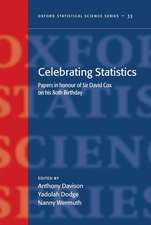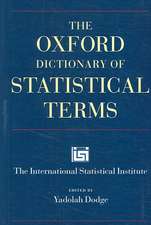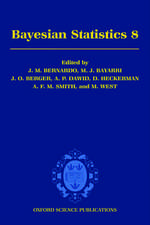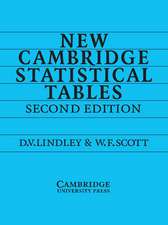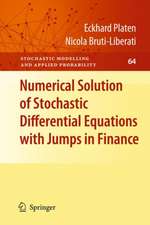Recursive Partitioning and Applications: Springer Series in Statistics
Autor Heping Zhang, Burton H. Singeren Limba Engleză Paperback – 5 sep 2012
| Toate formatele și edițiile | Preț | Express |
|---|---|---|
| Paperback (1) | 585.11 lei 39-44 zile | |
| Springer – 5 sep 2012 | 585.11 lei 39-44 zile | |
| Hardback (1) | 702.05 lei 6-8 săpt. | |
| Springer – 19 iul 2010 | 702.05 lei 6-8 săpt. |
Din seria Springer Series in Statistics
- 14%
 Preț: 679.60 lei
Preț: 679.60 lei - 20%
 Preț: 630.97 lei
Preț: 630.97 lei - 20%
 Preț: 816.43 lei
Preț: 816.43 lei - 20%
 Preț: 1000.84 lei
Preț: 1000.84 lei -
 Preț: 390.84 lei
Preț: 390.84 lei - 20%
 Preț: 697.13 lei
Preț: 697.13 lei - 20%
 Preț: 445.20 lei
Preț: 445.20 lei - 20%
 Preț: 881.51 lei
Preț: 881.51 lei - 18%
 Preț: 1237.14 lei
Preț: 1237.14 lei - 18%
 Preț: 967.22 lei
Preț: 967.22 lei - 18%
 Preț: 956.50 lei
Preț: 956.50 lei - 18%
 Preț: 794.25 lei
Preț: 794.25 lei - 15%
 Preț: 648.05 lei
Preț: 648.05 lei - 18%
 Preț: 1222.49 lei
Preț: 1222.49 lei - 15%
 Preț: 646.11 lei
Preț: 646.11 lei - 15%
 Preț: 647.08 lei
Preț: 647.08 lei - 15%
 Preț: 646.11 lei
Preț: 646.11 lei - 18%
 Preț: 1389.62 lei
Preț: 1389.62 lei - 15%
 Preț: 652.81 lei
Preț: 652.81 lei - 18%
 Preț: 1114.52 lei
Preț: 1114.52 lei - 18%
 Preț: 952.40 lei
Preț: 952.40 lei - 18%
 Preț: 1393.27 lei
Preț: 1393.27 lei - 18%
 Preț: 1561.68 lei
Preț: 1561.68 lei - 18%
 Preț: 1231.47 lei
Preț: 1231.47 lei - 15%
 Preț: 513.64 lei
Preț: 513.64 lei - 18%
 Preț: 893.71 lei
Preț: 893.71 lei - 15%
 Preț: 649.87 lei
Preț: 649.87 lei - 18%
 Preț: 1007.65 lei
Preț: 1007.65 lei - 18%
 Preț: 1111.67 lei
Preț: 1111.67 lei - 18%
 Preț: 1229.10 lei
Preț: 1229.10 lei - 18%
 Preț: 892.74 lei
Preț: 892.74 lei - 18%
 Preț: 913.26 lei
Preț: 913.26 lei - 18%
 Preț: 943.88 lei
Preț: 943.88 lei -
 Preț: 391.61 lei
Preț: 391.61 lei -
 Preț: 391.22 lei
Preț: 391.22 lei - 18%
 Preț: 1391.04 lei
Preț: 1391.04 lei -
 Preț: 390.84 lei
Preț: 390.84 lei - 18%
 Preț: 893.84 lei
Preț: 893.84 lei - 18%
 Preț: 960.61 lei
Preț: 960.61 lei - 18%
 Preț: 1245.34 lei
Preț: 1245.34 lei - 18%
 Preț: 964.54 lei
Preț: 964.54 lei - 15%
 Preț: 643.16 lei
Preț: 643.16 lei - 18%
 Preț: 1674.70 lei
Preț: 1674.70 lei - 15%
 Preț: 643.84 lei
Preț: 643.84 lei - 15%
 Preț: 586.37 lei
Preț: 586.37 lei - 18%
 Preț: 1004.99 lei
Preț: 1004.99 lei - 15%
 Preț: 643.34 lei
Preț: 643.34 lei - 18%
 Preț: 806.40 lei
Preț: 806.40 lei - 18%
 Preț: 727.66 lei
Preț: 727.66 lei
Preț: 585.11 lei
Preț vechi: 769.88 lei
-24% Nou
Puncte Express: 878
Preț estimativ în valută:
111.99€ • 116.47$ • 93.85£
111.99€ • 116.47$ • 93.85£
Carte tipărită la comandă
Livrare economică 10-15 martie
Preluare comenzi: 021 569.72.76
Specificații
ISBN-13: 9781461426226
ISBN-10: 1461426227
Pagini: 276
Ilustrații: XIV, 262 p.
Dimensiuni: 155 x 235 x 14 mm
Greutate: 0.45 kg
Ediția:Softcover reprint of hardcover 2nd ed. 2010
Editura: Springer
Colecția Springer
Seria Springer Series in Statistics
Locul publicării:New York, NY, United States
ISBN-10: 1461426227
Pagini: 276
Ilustrații: XIV, 262 p.
Dimensiuni: 155 x 235 x 14 mm
Greutate: 0.45 kg
Ediția:Softcover reprint of hardcover 2nd ed. 2010
Editura: Springer
Colecția Springer
Seria Springer Series in Statistics
Locul publicării:New York, NY, United States
Public țintă
ResearchCuprins
A Practical Guide to Tree Construction.- Logistic Regression.- Classification Trees for a Binary Response.- Examples Using Tree-Based Analysis.- Random and Deterministic Forests.- Analysis of Censored Data: Examples.- Analysis of Censored Data: Concepts and Classical Methods.- Analysis of Censored Data: Survival Trees and Random Forests.- Regression Trees and Adaptive Splines for a Continuous Response.- Analysis of Longitudinal Data.- Analysis of Multiple Discrete Responses.
Notă biografică
Heping Zhang is Professor of Public Health, Statistics, and Child Study, and director of the Collaborative Center for Statistics in Science, at Yale University. He is a Fellow of the American Statistical Association and the Institute of Mathematical Statistics, a Myrto Lefkopoulou Distinguished Lecturer Awarded by Harvard School of Public Health, and a Medallion lecturer selected by the Institute of Mathematical Statistics.Burton Singer is Courtesy Professor in the Emerging Pathogens Institute at University of Florida, and previously Charles and Marie Robertson Professor of Public and International Affairs at Princeton University. He is a member of the National Academy of Sciences and Institute of Medicine of the National Academies, and a Fellow of the American Statistical Association.
Textul de pe ultima copertă
The routes to many important outcomes including diseases and ultimately death as well as financial credit consist of multiple complex pathways containing interrelated events and conditions. We have historically lacked effective methodologies for identifying these pathways and their non-linear and interacting features. This book focuses on recursive partitioning strategies as a response to the challenge of pathway characterization. A highlight of the second edition is the many worked examples, most of them from epidemiology, bioinformatics, molecular genetics, physiology, social demography, banking, and marketing. The statistical issues, conceptual and computational, are not only treated in detail in the context of important scientific questions, but also an array of substantively-driven judgments are explicitly integrated in the presentation of examples.Going considerably beyond the standard treatments of recursive partitioning that focus on pathway representations via single trees, this second edition has entirely new material devoted to forests from predictive and interpretive perspectives. For contexts where identification of factors contributing to outcomes is a central issue, both random and deterministic forest generation methods are introduced via examples in genetics and epidemiology. The trees in deterministic forests are reproducible and more easily interpretable than the components of random forests. Also new in the second edition is an extensive treatment of survival forests and post-market evaluation of treatment effectiveness.Heping Zhang is Professor of Public Health, Statistics, and Child Study, and director of the Collaborative Center for Statistics in Science, at Yale University. He is a Fellow of the American Statistical Association and the Institute of Mathematical Statistics, a Myrto Lefkopoulou Distinguished Lecturer Awarded by Harvard School of Public Health, and a Medallion lecturer selected by the Institute of Mathematical Statistics.Burton Singer is Courtesy Professor in the Emerging Pathogens Institute at University of Florida, and previously Charles and Marie Robertson Professor of Public and International Affairs at Princeton University. He is a member of the National Academy of Sciences and Institute of Medicine of the National Academies, and a Fellow of the American Statistical Association.
Caracteristici
Integrates conceptual and computational treatment of tree representations of complex pathways to important outcomes across diverse scientific applications Introduces random and alternative deterministic forests to facilitate interpretability of pathways with many contributing conditions and non-linear relationships Illustrates the interplay between scientific judgments and constraints on allowed pathway constructions; comparisons with conventional statistical methods Includes supplementary material: sn.pub/extras

